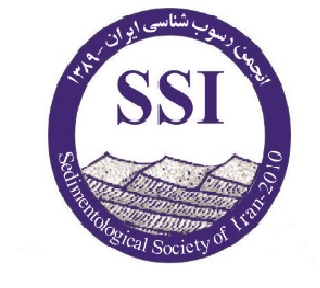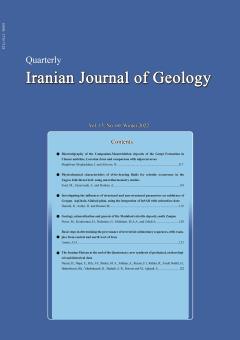Geology, mineralization and genesis of the Madabad celestite deposit, south Zanjan
Subject Areas :مهسا نوری 1 , Hossein Kouhestani 2 * , قاسم نباتیان 3 , میرعلی اصغر مختاری 4 , افشین زهدی 5
1 -
2 -
3 -
4 -
5 -
Keywords: Epigenetic, Zanjan, Qom Formation, Celestite mineralization, Madabad. ,
Abstract :
Rock units in the Madabad celestite deposit are composed of medium to thick-bedded and massive limestone interlayered with marly limestone and marl units of the Qom Formation (lower Miocene). Mineralization occurs as lens-shaped orebody, hosted by limestone units of member of the Qom Formation usually crosscutting bedding of the host rocks. Three stages of mineralization occurred in the Madabad deposit. The first stage is characterized by calcite formation during syn-depositional to syn-diagenesis processes. The second stage is related to hydrothermal processes that are distinguished by formation of fine-grained and sugary crystals of massive stage-1 celestite, vein-veinlets of coarse-grained stage-2 celestite along with minor strontianite and barite, coarse-grained euhedral crystals of stage-3 celestite with vug infilling texture, and finally late-stage quartz and calcite vein-veinlets. Stage three includes supergene processes. Hydrothermal alteration includes dolomitization, calcitization and silicification. Celestite along with minor strontianite and barite are ore minerals, and calcite, dolomite, quartz and iron oxides-hydroxides are gangue minerals at Madabad. The ore minerals show vein-veinlets, vug infilling, brecciated and cataclastic textures. Microthermometric measurements of two-phase liquid-rich fluid inclusions hosted in celestite II indicate that salinities values range from 6 to 18 wt.% NaCl equiv. (avg. 10.6 wt.% NaCl equiv.). These inclusions have homogenization temperatures range from 248 to 365 °C, with an average of 278 °C. These data indicate a minimum trapping depth of 510 m for the Madabad deposit. Sr was originated from evaporate units within the marly parts of the Qom Formation and volcanic units of the Karaj Formation. Characteristics of the Madabad deposit are similar to epigenetic replacement celestite deposits.
بازرگاني گيلاني، ك. و رباني، م.ص.، 1384. نهشت سلستيت استراتيفورم منطقه افتر، باختر سمنان. فصلنامه علوم زمین، 55، 41-30.
جمی، م.، 1370. زمینشناسی، ژئوشیمی و منشاء افق سلستیتدار منطقه بهمئی (سازند آسماري)، استان کهگیلویه و بویراحمد .پایاننامه کارشناسی ارشد، دانشگاه شیراز، 186.
دانشیان، ج.، اسدی مهماندوستی، ا. و رمضانی دانا، ل.، 1396. ریزرخساره، محیط رسوبی و چینهنگاری سکانسی سازند قم در برش دهنمک، شمالشرق گرمسار. فصلنامه زمینشناسی ایران، 11، 41، 43-23.
رستمی پایدار، ق.، طاهرزاده، ا. و عادلپور، م.، 1395. زمینشناسی و ژنز کانسار سلستیت بابامحمد در مرز گچساران و میشان، استان کهگلویه بویراحمد. یافتههای نوین زمینشناسی کاربردی، 20، 75-62.
شرکت فارس جم ستون، 1392. گزارش پایان اکتشاف کانسار سلستین مادآباد. سازمان صنعت، معدن و تجارت استان زنجان، 185.
شهیدی، ع. و بهار فیروزی، خ.، 1380. نقشه زمینشناسی حلب، مقیاس 1:100،000. سازمان زمینشناسی و اکتشافات معدنی کشور.
علوی نائینی، م.، 1372. نقشه زمینشناسی خدابنده- سلطانیه، مقیاس 1:100،000. سازمان زمینشناسی و اکتشافات معدنی کشور.
کریمی، ع. و راستاد، ا.، 1378. رخسارههای کانهدار کانسار سلستیت نخجیرکوه ورامین؛ تحول دیاژنزی و محیط رسوبگذاری. فصلنامه علوم زمین، 33، 33-20.
نوری، م.، زهدی، ا.، کوهستانی، ح.، نباتیان، ق. و مختاری، م.ع.ا.، 1397. چینهشناسی سنگی، ریزرخسارهها و محیط رسوبی سازند قم در بُرش کانسار سلستین مادآباد، جنوب زنجان. مجله رخسارههای رسوبی، 11، 2، 303-288.
نوری، م.، زهدی، ا.، کوهستانی، ح.، نباتیان، ق. و مختاری، م.ع.ا.، 1398. مطالعه کانیشناسی اولیه کربناتهای سازند قم با استفاده از مطالعات پتروگرافی و ژئوشیمیایی در بُرش کانسار سلستین مادآباد (جنوب زنجان). فصلنامه زمینشناسی ایران، 13، 51، 15-1.
Alavi, M., 1991. Tectonic map of the Middle East, scale 1:5000000. Geological Survey of Iran.
Bazargani-Guilani, K. and Nekouvaght Tak, M.A., 2008. Celestite ore deposit and occurrences of the Qom Formation, Oligo-Miocene, Central Iran. 2nd IASME/WSEAS international conference on geology and seismology, Cambridge, UK, 48–54.
Beane R.E. 1983. The magmatic–meteoric transition. Geothermal Resources Council, Special Report, 13, 245–253.
Bodnar, R.J., 1993. Revised equation and table for determining the freezing point depression of H2O–NaCl solution. Geochimical et Cosmochimca Acta, 57(3), 683–684.
Brodtkorb, M.K. de., Ramos, V., Barbieri, M. and Ametrano, S., 1982. The evaporitic celestine–barite deposits of Neuqen, Argentina. Mineralium Deposita, 17(3), 423–436.
Carlson, E.H., 1983. The occurrence of Misissippi Valley-type mineralization in northwestern Ohio. In: Kisvarsanyi G.S. Grant K. Pratt W.P. and Koeing J.W. (Eds.). International conference on Mississippi valey-type lead-zinc deposits. Procceding, University of Missouri Rollamo, 242–435.
Ceyhan, V., Cinemre, H.A. and Bozoglu, M., 1996. An analysis of supply and demand of hazelnut in Turkey. Proc. of the Nuts Symposium Samsun, Turkey, 12–46 (in Turkish).
Dill, H.G., 2010. The chessboard classification scheme of mineral deposits: mineralogy and geology from aluminum to zirconium. Earth Science Reviews, 100(1–4), 1–20.
Dove, P.M. and Czank, C.A., 1995. Crystal chemical controls on the dissolution kinetics of the isostructural sulfates–celestite, anglesite, and barite. Geochimica et Cosmochimica Acta, 59(10), 1907–1915.
Ehya, F., Shakouri, B. and Rafi, M., 2013. Geology, mineralogy, and isotope (Sr, S) geochemistry of the Likak celestite deposit, SW Iran. Carbonates and Evaporites, 28(4), 419–431.
Forjanes, P., Astilleros, J.M. and Fernández-Díaz, L., 2020a. The formation of barite and celestite through the replacement of gypsum. Minerals, 10, 189.
Forjanes, P., Gómez-Barreiro, J., Morales, J., Astilleros, J.M. and Fernández-Díaz, L., 2020b. Epitactic growth of celestite on anhydrite: substrate induced twinning and morphological evolution of aggregates. CrystEngComm, 22(35), 5743–5759.
Furrer, M.A. and Soder, P.A., 1955. The Oligo-Miocene Formation in the Qom region (Iran). Processing of 4th World Petroleum Congress, 6-15 June, Roma, Italy, 267-277.
González-Sánchez, F., Camprubí, A., González-Partida, E., Puente-Solís, R., Canet, C., Centeno-García, E. and Atudorei, V., 2009. Regional stratigraphy and distribution of epigenetic stratabound celestine, fluorite, barite and Pb–Zn deposits in the MVT province of northeastern Mexico. Mineralium Deposita, 44, 343–361.
Hanor, J.S., 2004. A model for the origin of large carbonate- and evaporite-hosted celestine deposits. Journal of Sedimentary Research, 74(2), 168–175.
Hitzman, M.W., Redmon, P.B. and Beaty, D.W., 2002. The carbonte-hosted Lisheen Zn–Pb–Ag deposit, County Tipperary, Ireland. Economic Geology, 97(8), 1627–1655.
Karamanderesi, I.H., Kiliçdaği, R. and Kiliç, N., 1992. Relationship between Sýcakçermik (Sivas) geothermal system and celestine formation. Türkiye Jeo. Kurult. Bildi. Özleri, 65 (in Turkish).
Kesler, S.E., 2005. Ore-forming fluids. Elements, 1, 13–18.
Kinsman, D.J.J., 1969. Modes of formation, sedimentary associations, and diagenetic features of shallow-water supratidal evaporites. Amemican Association Petrolium Geology Bulletin, 53(4), 830–840.
Kushnir, S.V., 1986. The epigenetic celestiting formation mechanism for rock containing CaSO4. Geochemistry, 23, 1–9.
Markhand, A.H., Agheem, M.H., Shaikh, S.A., Khokhar, Q.D., Sahit, A.G. and Jamali, M.A., 2020. Mineralogical and Geochemical investigations of Celestite and Gypsum from GanjoTakkar area, Hyderabad, Sindh, Pakistan. Sindh University Research Journal (Science Series), 52(3), 263–272.
Martin, J.M., Ortega-Huertas, M. and Torres-Ruiz, J., 1984. Genesis and evolution of strontium deposits of the Granada basin (Southestern Spain): evidence of diagenetic replacement of a stromatolite belt. Sedimentary Geology, 39(3–4), 281–298.
Nickless, E.F.P., Booth, S.J. and Mosley, P.N., 1975. Celestite deposits of the Bristol area. Transaction Institute of Mining and Metallurgy, Section B., 84, B62–B63.
Pourkaseb, H., Zarasvandi, A., Rezaei, M., Mahdavi, R. and Ghanavati, F., 2017. The occurrence and origin of celestite in the Abolfares region, Iran: Implications for Sr-mineralization in Zagros fold belt (ZFB). Journal of African Earth Sciences, 134, 352–364.
Ramos, V.A. and Brodtkorb, M.K. de., 1990. Thr barit and celestite metallotects of the Neuquén retroarc basin, centeral Argentina. In: Stratabound ore deposits in the Andes, Springer Verlag, Heidelberg. 47, 599–613.
Ranjbaran, M., Moghaddasi, S.J. and Sotohian, F., 2014. Texture study of the Mazraeh celestite deposit from North Central Iran. Journal of Tethys, 2(1), 20–28.
Roedder, E., 1984. Fluid inclusions. Reviews in Mineralogy. Mineralogical Society of America, Washington, 12, 644.
Ruiz, J., Kesler, S.E., Jones, L.M. and Sutter, J.F., 1980. Geology and geochemistry of the Las Cuevas fluorite deposit, San Luis Potosi, Mexico. Economic Geology, 75, 1200–1209.
Scholle, P.A., Stemmerik, L. and Harpoth, O., 1990. Origin of major karst-associated celestine mineralization in Karstrynggen, Central East Greenland. Journal of Sedimentary Research, 60(3), 397–410.
Tekin, E., 2001. Stratigraphy, geochemistry and depositional environment of the celestine-bearing gypsiferous Formations of the Tertiary Ulaş-Sivas Basin, East-Central Anatolia (Turkey). Turkish Journal of Earth Sciences, 10, 35–49.
Tekin, E., Varol, B., Ayan, Z. and Satir, M., 2002. Epigenetic origin of celestite deposits in the Tertiary Sivas Basin: New mineralogical and geochemical evidence. Neues Jahrbuch für Mineralogie-Abhandlungen (Journal of Mineralogy and Geochemistry), 7, 289–318.
Warren, J.K., 2006. Evaporites: Sediments, Resources and Hydrocarbons. Springer Science and Business Media, Berlin, Germany.
Whitney, D.L. and Evans, B.W., 2010. Abbreviations for names of rock-forming minerals. Amican Mineralogist, 95(1), 185–187.
Wilkinson, J.J., Eyre, S. and Boyce, A., 2005. Ore-forming processes in Irish-type carbonate-hosted Zn–Pb deposits: Evidence from mineralogy, chemistry, and isotopic composition of sulfides at the Lisheen mine. Economic Geology, 100(1), 63–86.
Wood, M.W. and Shaw, H.F., 1976. The geochemistry of celestites from the Yate area near Bristol (UK). Chemical Geology, 17, 179–193.

